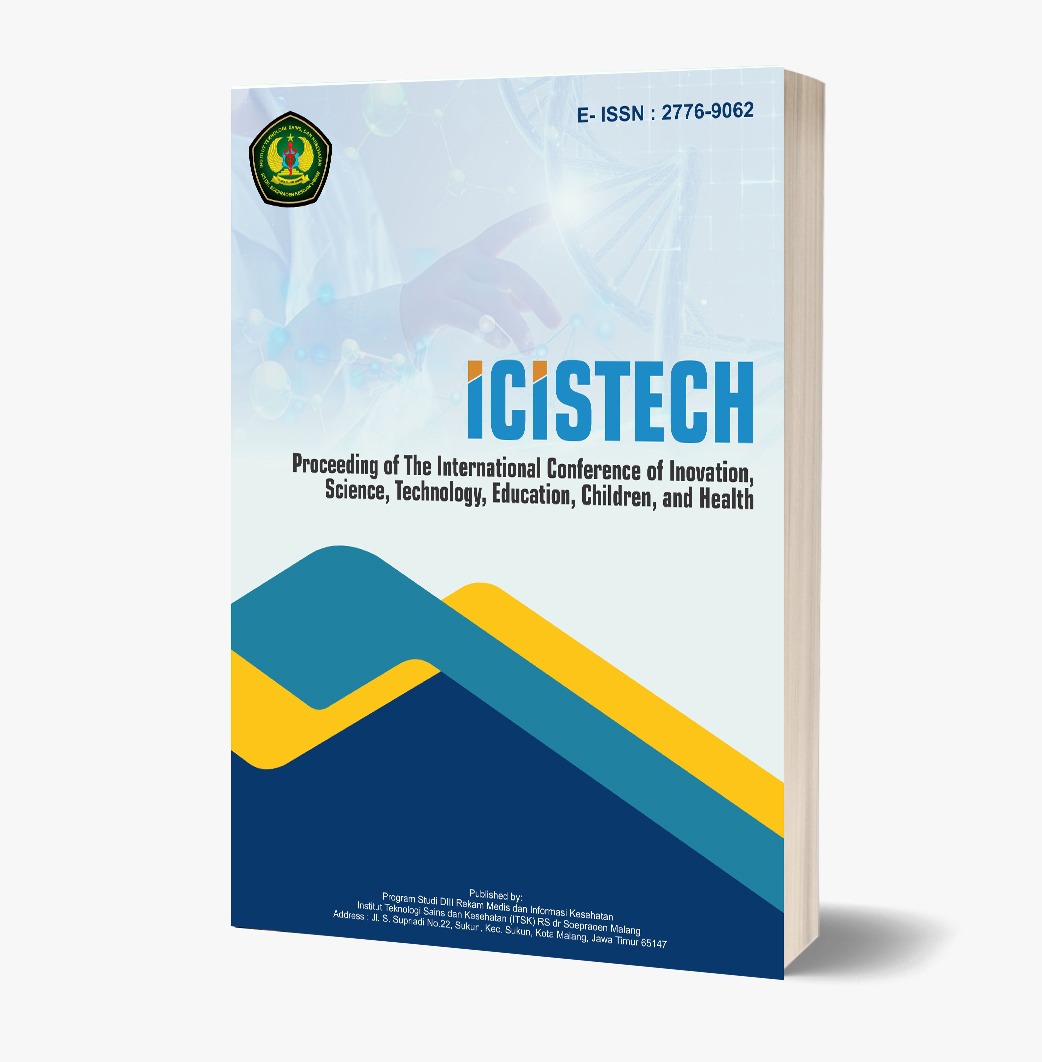The Effect of Birthing Ball Use on the Duration of the First Stage of Active Labor
DOI:
https://doi.org/10.62951/icistech.v5i1.281Keywords:
1st Stage, Birthing Ball, Length of LaborAbstract
Birth and delivery are normal physiological events involving the expulsion of the fetus that occurs during 37-42 weeks (full term pregnancy). For a mother, the labor process can cause fear and pain so that the risk of labor that is too long increases. By using a birthing ball, the mother can move more comfortably and experience less pain, so that labor will be shorter. This study aims to determine the Effect of Using a Birthing Ball on the Length of Stage 1 of the Active Phase at the Paguyaman Gorontalo Health Center. The purpose of this study was to analyze how the birthing ball method affects the length of the active phase I stage. The design of this study was a static Group Comparison pre-experimental design. Statistical tests with the Independent T Test. The population of this study were mothers giving birth at the Paguyaman Gorontalo Health Center. The sample consisted of 32 people. The results of the study on the use of birthing balls obtained an average labor progress of 288 minutes. The results of the statistical test with a significance value of 0.00 which means p <0.05. The conclusion of this study is that there is a significant influence in the use of the birthing ball method on the length of the first active phase in mothers giving birth in the Paguyaman Gorontalo Health Center Area. Suggestions for health workers in making plans to improve maternal care during labor by using birthing balls to help the progress of labor
References
Dewi, A. T., Palngestu, G. K., Febriyalni, P. A. L., & Jubaledalh, D. (2024). Efektivitas posisi miring kiri dan penggunaan birth ball dalam mempercepat persalinan kala 1 aktif pada ibu bersalin di UPTD Puskesmas Ralwalt Inalp Ciralnjalng Kabupaten Cianjur. Jurnal Kesehatan, 4, 4232–4245.
Ginting, L., et al. (2019). Efektivitas aromaterapi lemon terhadap pengurangan nyeri persalinan, lama persalinan kala II, dan fetal outcome. Jurnal Kedokteran Keluarga, 2(1). https://doi.org/10.35451/jkk.v2i1.245
Grenvik, J. M., Coleman, L. A., & Berghella, V. (2023). Expert review: Birthing balls to decrease labor pain and peanut balls to decrease length of labor: What is the evidence? American Journal of Obstetrics and Gynecology, 228(5), S1270–S1273. https://doi.org/10.1016/j.ajog.2023.02.014
Journall, H. C., et al. (2022). Pengaruh pijat perineum pada ibu hamil primigravida trimester III terhadap derajat ruptur perineum. Jurnal Kesehatan, 7(2), 318–322. https://doi.org/10.32883/hcj.v7i2.1672
Jumaltrin, N. F., et al. (2022). Gambaran indikasi persalinan sectio caesarea di RSUD Kota Kendal Tahun 2018. Jurnal Kesehatan, 6. https://doi.org/10.46233/jk.v6i01.870
Ralkizalh, I., Ralhmalwalti, D. T., & Kaldalrsih, M. (2023). Studi literatur penggunaan gym ball pada ibu hamil primigravida untuk mempercepat durasi persalinan. Jurnal Vokes, 2(1), 7–12. https://doi.org/10.58222/juvokes.v2i1.137
Salfitri, J., Sunalrsih, & Yulialsalri, D. (2020). Terapi relaksasi (Napals Dalam) dalam mengurangi nyeri persalinan. Jurnal Kedokteran, 9(3), 365–370. https://doi.org/10.33024/jdk.v9i3.3003
Sri, I., Balti, E., & Rosmini, S. (2023). Hubungan antara terapi birthing ball dengan kemajuan persalinan kala I false aktif. Jurnal Kesehatan, 4.
Walhyuni, E. T., & Utalmi, I. (2022). Pengaruh pelaksanaan teknik birth ball terhadap lama persalinan kala I. Jurnal Kesehatan, 13(02), 298–304.
Wilialndalri, M., & Salgital, Y. D. (2021). Universitas Alisyalh Pringsewu: Kecelakaan pada Ratusan Kabupaten Lampung Tengah Tahun 2021. Jurnal Kesehatan, 2(2), 167–173.
Yurialti, P., & Suryalnal, F. (2020). Persalinan normal dengan menggunakan birth ball terhadap kelancaran persalinan. Jurnal Kesehatan, XI(02).
Yulialnti, S., & Murwalti, M. (2023). The influence of birth ball on the length of period 1 of labor. Jurnal Kesehatan, 11(2), 373–377.
Aliyalh, N., Ralngkuti, R., & Halralhalp, M. A. (2020). Hubungan pengetahuan dan usia ibu hamil dengan kehamilan risiko tinggi di puskesmas labuhan ralsoki. Jurnal Kesehatan, 8(4), 513–517.
T. Dewi, G. K. Palngestu, P. A. L. Febriyalni, & D. Jubaledalh, (2024). Efektivitas posisi miring kiri dan penggunaan birth ball dalam mempercepat persalinan kala 1 aktif pada ibu bersalin di UPTD Puskesmas Ralwalt Inalp Ciralnjalng Kabupaten Cianjur. Jurnal Kesehatan, 4, 4232–4245.
Ralkizalh, I., D. T. Ralhmalwalti, & M. Kaldalrsih, (2023). Studi literatur Penggunaan Gym Ball Pada Ibu Hamil Primigravida Untuk Mempercepat Durasi Persalinan. Jurnal Vokes, 2(1), 7-12. https://doi.org/10.58222/juvokes.v2i1.137
Downloads
Published
How to Cite
Issue
Section
License
Copyright (c) 2025 Proceeding of The International Conference of Inovation, Science, Technology, Education, Children, and Health

This work is licensed under a Creative Commons Attribution-ShareAlike 4.0 International License.













